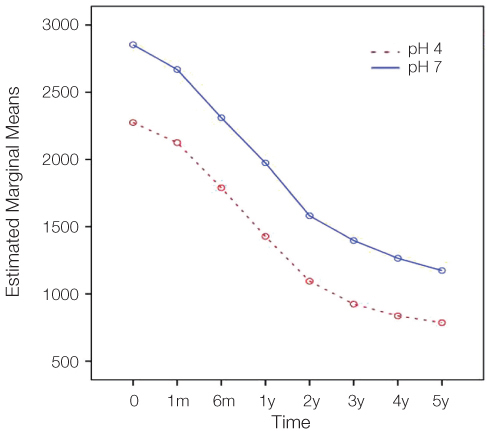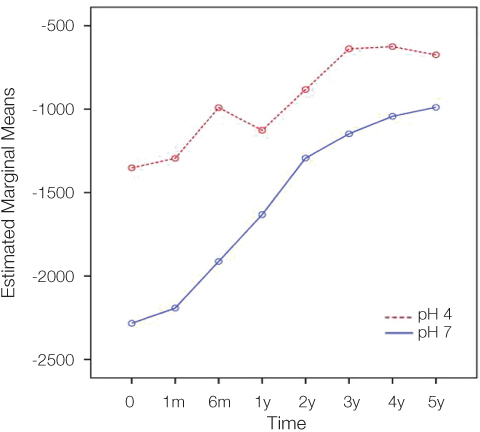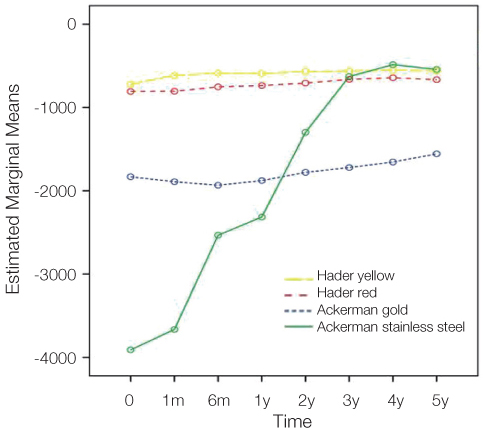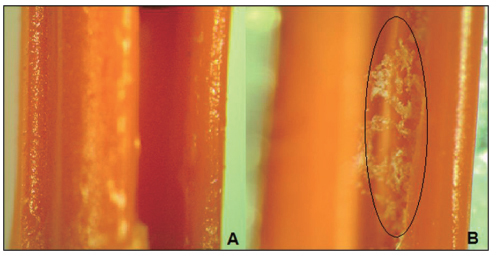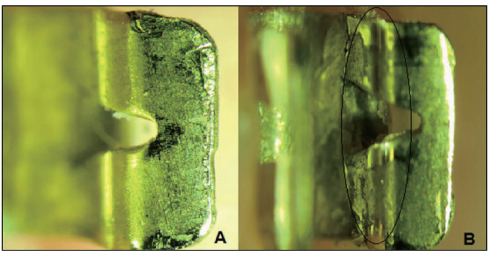J Adv Prosthodont.
2015 Feb;7(1):32-38. 10.4047/jap.2015.7.1.32.
The influence of saliva pH value on the retention and durability of bar-clip attachments
- Affiliations
-
- 1Department of Oral Rehabilitation, Instituto Superior de Ciencias da Saude - Norte, Gandra, Portugal. antonio.sergio.oliveira.silva@gmail.com
- 2Industrial Engineer, Chairman of Idearum, Enginyeria i Innovacio de Producte, Igualada, Barcelona, Spain.
- 3Department of Production and Systems Engineering, University of Minho (UM), Braga, Portugal.
- 4Department of Rehabilitation and Maxillofacial Prostheses, Faculty of Odontology, University of Barcelona, Barcelona, Spain.
- KMID: 1974888
- DOI: http://doi.org/10.4047/jap.2015.7.1.32
Abstract
- PURPOSE
The aim of this study was to compare the durability and retention of 4 types of attachments placed over computer aided design/computer aided manufacturing (CAD/CAM) titanium bars when subjected to different pH conditions.
MATERIALS AND METHODS
Four commercially available attachments were investigated: Hader Yellow, Hader Red, Ackerman Gold and Ackerman Stainless Steel. These attachments and Ackerman CAD/CAM titanium bars were placed in 2 vessels containing different artificial saliva solutions (pH 7/pH 4) at 37degrees C for one month to simulate corrosion conditions, and they were then subjected to mechanical testing (5400 cycles of insertion and removal).
RESULTS
The results revealed that there were significant differences in the average values of insertion/removal force due to the pH (F (1, 24)=9.207, P<.05) and the type of attachment (F (3, 24)=11.742, P<.05).
CONCLUSION
More acidic pH values were found to have a negative influence on the retention capacity of the attachments.
MeSH Terms
Figure
Reference
-
1. Carlsson GE. Early in contrast to recent methods to evaluate masticatory function in implant patients. J Prosthodont Res. 2012; 56:3–10.2. McKenna G, Lillywhite G. Accelerated rehabilitation of an edentulous patient with an implant retained dental prosthesis: a case report. Gerodontology. 2007; 24:181–184.3. Mijiritsky E. Implants in conjunction with removable partial dentures: a literature review. Implant Dent. 2007; 16:146–154.4. Waddell JN, Payne AG, Swain MV. Physical and metallurgical considerations of failures of soldered bars in bar attachment systems for implant overdentures: a review of the literature. J Prosthet Dent. 2006; 96:283–288.5. Al-Nawas B, Brägger U, Meijer HJ, Naert I, Persson R, Perucchi A, Quirynen M, Raghoebar GM, Reichert TE, Romeo E, Santing HJ, Schimmel M, Storelli S, ten Bruggenkate C, Vandekerckhove B, Wagner W, Wismeijer D, Müller F. A double-blind randomized controlled trial (RCT) of Titanium-13Zirconium versus Titanium Grade IV small-diameter bone level implants in edentulous mandibles--results from a 1-year observation period. Clin Implant Dent Relat Res. 2012; 14:896–904.6. Assunção WG, Barão VA, Delben JA, Gomes EA, Tabata LF. A comparison of patient satisfaction between treatment with conventional complete dentures and overdentures in the elderly: a literature review. Gerodontology. 2010; 27:154–162.7. Chaccur D, Lopes FM, Nakamae AEM, Frigerio MLMA, Neto PT, Laganá DC. Analise critica das construcoes proteticas, fixas e removiveis, sobre implantes em pacientes edentados. Critical analysis of the fixed and removable implant prosthesis on implants in edentulous patients. Rev Odontol Univ Cid Sao Paulo. 2010; 22:240–246.8. Chikunov I, Doan P, Vahidi F. Implant-retained partial overdenture with resilient attachments. J Prosthodont. 2008; 17:141–148.9. Fromentin O, Lassauzay C, Abi Nader S, Feine J, de Albuquerque Junior RF. Testing the retention of attachments for implant overdentures - validation of an original force measurement system. J Oral Rehabil. 2010; 37:54–62.10. Fu CC, Hsu YT. A comparison of retention characteristics in prefabricated and custom-cast dental attachments. J Prosthodont. 2009; 18:388–392.11. Gulizio MP, Agar JR, Kelly JR, Taylor TD. Effect of implant angulation upon retention of overdenture attachments. J Prosthodont. 2005; 14:3–11.12. Kobayashi M, Srinivasan M, Ammann P, Perriard J, Ohkubo C, Müller F, Belser UC, Schimmel M. Effects of in vitro cyclic dislodging on retentive force and removal torque of three overdenture attachment systems. Clin Oral Implants Res. 2014; 25:426–434.13. Jabbour Z, Fromentin O, Lassauzay C, Abi Nader S, Correa JA, Feine J, de Albuquerque Junior RF. Effect of implant angulation on attachment retention in mandibular two-implant overdentures: a clinical study. Clin Implant Dent Relat Res. 2014; 16:565–571.14. Chen KW, Lin TM, Liu PR, Ramp LC, Lin HJ, Wu CT, Pan YH. An analysis of the implant-supported overdenture in the edentulous mandible. J Oral Rehabil. 2013; 40:43–50.15. Pigozzo MN, Mesquita MF, Henriques GE, Vaz LG. The service life of implant-retained overdenture attachment systems. J Prosthet Dent. 2009; 102:74–80.16. Rutkunas V, Mizutani H, Takahashi H. Evaluation of stable retentive properties of overdenture attachments. Stomatologija. 2005; 7:115–120.17. Rutkunas V, Mizutani H, Takahashi H, Iwasaki N. Wear simulation effects on overdenture stud attachments. Dent Mater J. 2011; 11. 25.18. Ortegón SM, Thompson GA, Agar JR, Taylor TD, Perdikis D. Retention forces of spherical attachments as a function of implant and matrix angulation in mandibular overdentures: an in vitro study. J Prosthet Dent. 2009; 101:231–238.19. Turkyilmaz I, Company AM, McGlumphy EA. Should edentulous patients be constrained to removable complete dentures? The use of dental implants to improve the quality of life for edentulous patients. Gerodontology. 2010; 27:3–10.20. Abi Nader S, de Souza RF, Fortin D, De Koninck L, Fromentin O, Albuquerque Junior RF. Effect of simulated masticatory loading on the retention of stud attachments for implant overdentures. J Oral Rehabil. 2011; 38:157–164.21. Balaguer J, García B, Peñarrocha M, Peñarrocha M. Satisfaction of patients fitted with implant-retained overdentures. Med Oral Patol Oral Cir Bucal. 2011; 16:e204–e209.22. Evtimovska E, Masri R, Driscoll CF, Romberg E. The change in retentive values of locator attachments and hader clips over time. J Prosthodont. 2009; 18:479–483.23. Maeda Y, Horisaka M, Yagi K. Biomechanical rationale for a single implant-retained mandibular overdenture: an in vitro study. Clin Oral Implants Res. 2008; 19:271–275.24. Vogel RC. Implant overdentures: a new standard of care for edentulous patients current concepts and techniques. Compend Contin Educ Dent. 2008; 29:270–276.25. Chaturvedi TP. An overview of the corrosion aspect of dental implants (titanium and its alloys). Indian J Dent Res. 2009; 20:91–98.26. Geurtsen W. Biocompatibility of dental casting alloys. Crit Rev Oral Biol Med. 2002; 13:71–84.27. Antunes RA, de Oliveira MC. Corrosion fatigue of biomedical metallic alloys: mechanisms and mitigation. Acta Biomater. 2012; 8:937–962.28. Mikulewicz M, Chojnacka K. Release of metal ions from orthodontic appliances by in vitro studies: a systematic literature review. Biol Trace Elem Res. 2011; 139:241–256.29. Queiroz GM, Silva LF, Ferreira JT, Gomes JA, Sathler L. Electrochemical behavior and pH stability of artificial salivas for corrosion tests. Braz Oral Res. 2007; 21:209–215.30. Gürsoy S, Acar AG, Seşen C. Comparison of metal release from new and recycled bracket-archwire combinations. Angle Orthod. 2005; 75:92–94.31. Kuhta M, Pavlin D, Slaj M, Varga S, Lapter-Varga M, Slaj M. Type of archwire and level of acidity: effects on the release of metal ions from orthodontic appliances. Angle Orthod. 2009; 79:102–110.
- Full Text Links
- Actions
-
Cited
- CITED
-
- Close
- Share
- Similar articles
-
- A STUDY ON THE CHANGES IN RETENTION OF CLIPS USED TO RETAIN IMPLANT-SUPPORTED OVERDENTURE
- Comparative studies of retentive forces in maxillary overdenture bar attachments
- Effect of abutment angulation in the retention and durability of three overdenture attachment systems: An in vitro study
- Effects Of Overdenture Retention On The Axial Load Of Implant In The Mandibular Implant-Supported Overdenture
- Stability of the prosthetic screws of three types of craniofacial prostheses retention systems


